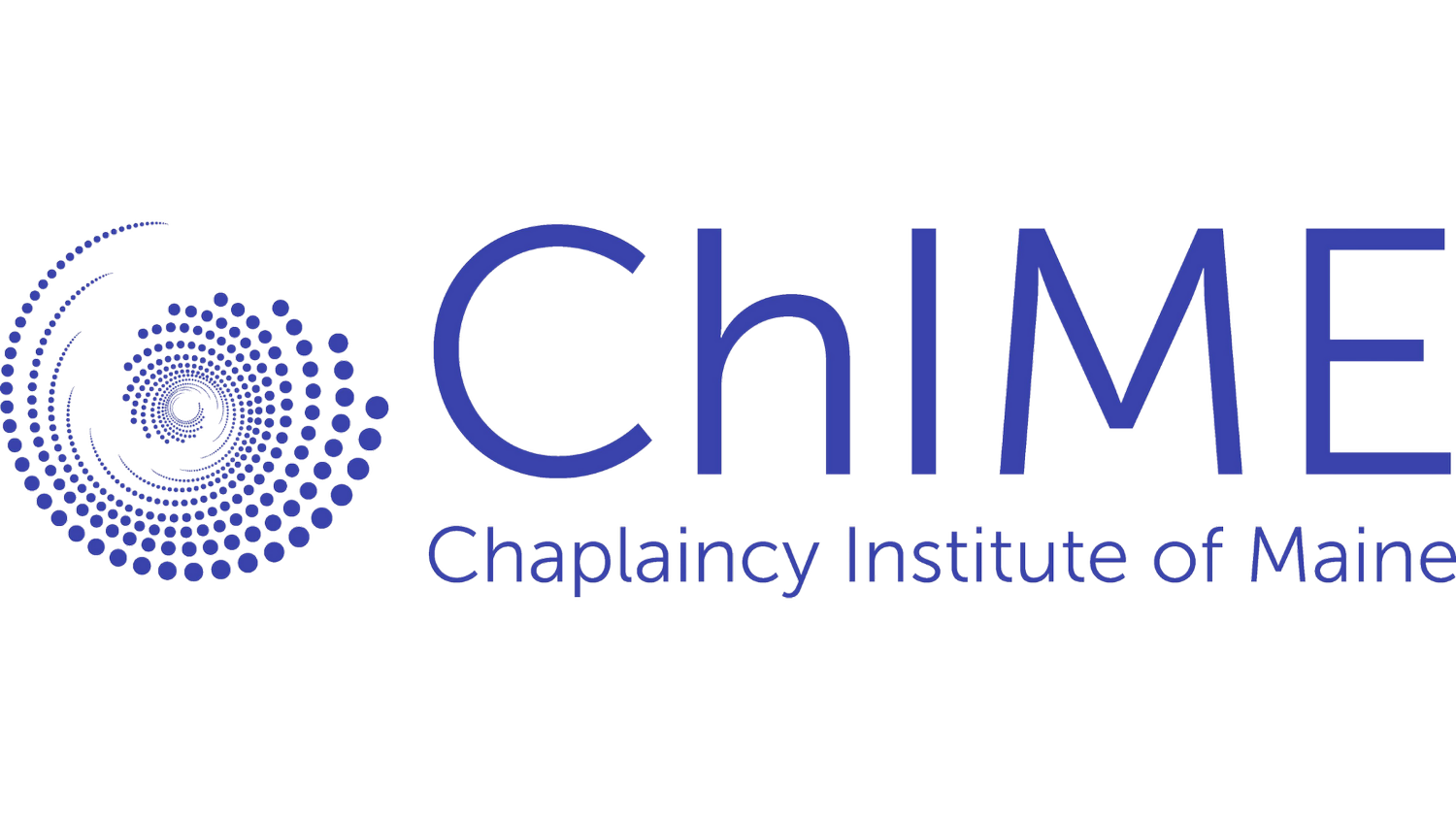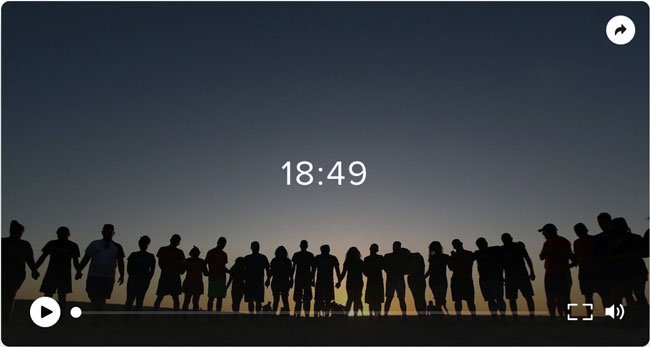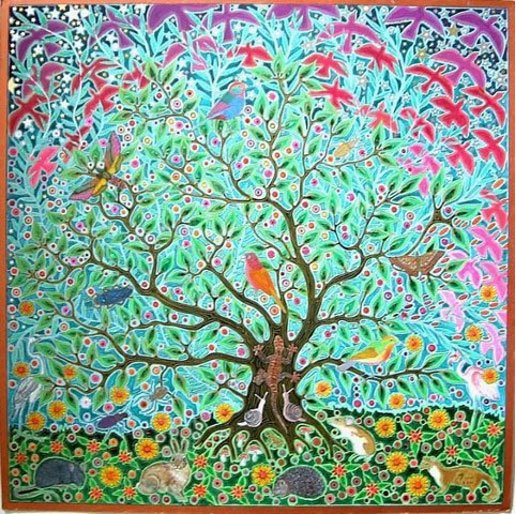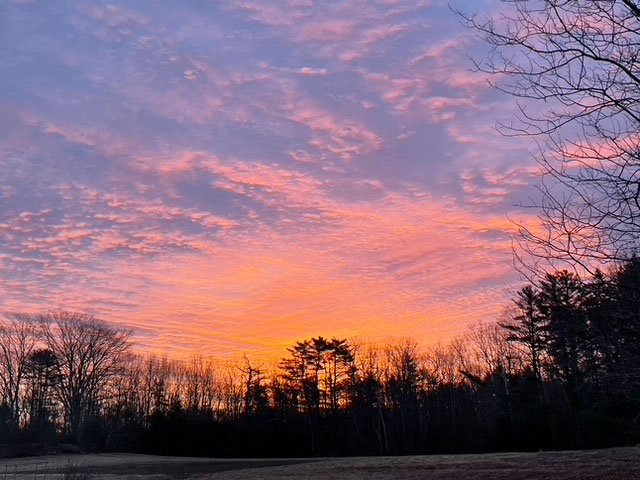
By Lisa Steele-Maley,
Last night, as I stood under the stars, the waxing crescent moon caught my eye. Over the next ten days, its light will steadily grow until it is high in the sky, illuminating the midnight field as if it were twilight. I imagine the snow and ice will continue their slow and steady melt during that same time.
The signs of spring are clear. The eaves of the roof are dripping steadily. In the morning, the smell of the skunk who passed by in the night lingers and the early birds persistently declare their presence. The critters are stirring. It is no wonder that I am stirring too.
I am a lover of light. My body is fully aware that we are nearing the spring equinox. The current cycle of the moon amplifies that recognition. Longer, brighter, warmer days infuse my body with energy, my mind with creativity, and my heart with gratitude. Bright moonlit nights encourage me to linger on my evening walk.
While the light is growing, the darkness is receding. There is a gentle gestation that can only happen under the shroud of darkness and the deep, contemplative hibernation of winter. It is hard to simply let go of the safety and comfort of the dark cave that has held and nurtured me through the previous long months. But when I honor it and give thanks for it, I can hold both the shrinking, dark coolness and the expanding, bright warmth with equal appreciation.
I am reminded to remain present. There is abundant beauty, love, and learning in each moment. I feel them deeply when I attend to the reality that each moment contains the delicate balance between light and dark, expansion and contraction. The present moment is the only time and place to experience the fullness of life’s offering.
An excerpt from Arriving Here: Reflections from the Hearth and Trail, now available at your local bookstore or online. Learn more, read reviews, and order. Register for the book launch March 10, 17, 24. In her actions and her words, Lisa Steele-Maley weaves together her roles as mother, daughter, wife, writer, and educator. Ordained by the Chaplaincy Institute of Maine (ChIME) in 2019, Lisa nurtures the fierce and tender connections between self, spirit, land, and community. Her writing reflects a strong connection to the affirming rhythms of the natural world and keen attention to the details of daily living and relationships.
In her actions and her words, Lisa Steele-Maley weaves together her roles as mother, daughter, wife, writer, and educator. Ordained by the Chaplaincy Institute of Maine (ChIME) in 2019, Lisa nurtures the fierce and tender connections between self, spirit, land, and community. Her writing reflects a strong connection to the affirming rhythms of the natural world and keen attention to the details of daily living and relationships.
Lisa lives in an aging farmhouse on the coast of Maine with her husband, two teenage sons, and a handful of animals. Her newest book, Arriving Here: Reflections from the Heart and Trail, was published in December 2020. Learn more at lisa.steelemaley.io.
Arriving Here cover photograph by Lisa Steele-Maley, book cover design by Lindy Gifford.


 Rev. Jacob Watson, D.Min. is the author of We’re Gainin’: Collins Brook, A Maine Free School—A Memoir, which he wrote to celebrate the 50th anniversary of the school’s founding in 1969. Jacob founded Collins Brook School and the Chaplaincy Institute of Maine. He is teaching a pilot interfaith chaplaincy program to students in Brazil and Guatemala. His Morning Blessing Gift meditations and Mini-Satsangs are available as audio recordings on the free meditation app Insight Timer. He may be reached through his web site
Rev. Jacob Watson, D.Min. is the author of We’re Gainin’: Collins Brook, A Maine Free School—A Memoir, which he wrote to celebrate the 50th anniversary of the school’s founding in 1969. Jacob founded Collins Brook School and the Chaplaincy Institute of Maine. He is teaching a pilot interfaith chaplaincy program to students in Brazil and Guatemala. His Morning Blessing Gift meditations and Mini-Satsangs are available as audio recordings on the free meditation app Insight Timer. He may be reached through his web site 
 Joyce Zonana, a regular contributor to the online journal
Joyce Zonana, a regular contributor to the online journal 
 Sivani Katie Gelfand is the Director of Religious Exploration at the First Unitarian Universalist Church of New Orleans, the congregation in which she was raised. Concurrent to this ministry she is also a certified Spiritual Guide and Reiki Master Teacher. Sivani believes healing is the process of strengthening, deepening, and surrendering ourselves in the name of transformation. She is committed to compassionately supporting others along their journey to wholeness by guiding individuals to nurture and trust the deep wisdom of their own hearts.
Sivani Katie Gelfand is the Director of Religious Exploration at the First Unitarian Universalist Church of New Orleans, the congregation in which she was raised. Concurrent to this ministry she is also a certified Spiritual Guide and Reiki Master Teacher. Sivani believes healing is the process of strengthening, deepening, and surrendering ourselves in the name of transformation. She is committed to compassionately supporting others along their journey to wholeness by guiding individuals to nurture and trust the deep wisdom of their own hearts. 
 gkisedtanamoogk, is from the Wampanoag Community of Mashpee located on cape cod south of boston, massachusetts, married to Miigam’agan. Together they have three Children and three Grandchildren. He was one of five Commissioners on the Maine Wabanaki State Child Welfare Truth and Reconciliation Commission and taught for 10 years at the University of Maine. He has shared several presentations with the Chaplaincy Institute of Maine. gkisedtanamoogk resides with his Family at Esgenoôpetitj on the Burnt Church Reserve; he would say that Mi’kmaq Homelands are occupied by the province of new brunswick and canada.
gkisedtanamoogk, is from the Wampanoag Community of Mashpee located on cape cod south of boston, massachusetts, married to Miigam’agan. Together they have three Children and three Grandchildren. He was one of five Commissioners on the Maine Wabanaki State Child Welfare Truth and Reconciliation Commission and taught for 10 years at the University of Maine. He has shared several presentations with the Chaplaincy Institute of Maine. gkisedtanamoogk resides with his Family at Esgenoôpetitj on the Burnt Church Reserve; he would say that Mi’kmaq Homelands are occupied by the province of new brunswick and canada.
 Robert Atkinson, PhD, author, educator, and developmental psychologist, is a 2017 Nautilus Book Award winner for The Story of Our Time: From Duality to Interconnectedness to Oneness. He is also the author or co-editor of eight other books, including Our Moment of Choice: Evolutionary Visions and Hope for the Future (2020), Year of Living Deeply: A Memoir of 1969 (2019), Mystic Journey: Getting to the Heart of Your Soul’s Story (2012), and The Gift of Stories (1995). He is professor emeritus at the University of Southern Maine, founder of One Planet Peace Forum, a member of the Evolutionary Leaders, and deeply committed to assisting the evolution of consciousness toward wholeness and unity.
Robert Atkinson, PhD, author, educator, and developmental psychologist, is a 2017 Nautilus Book Award winner for The Story of Our Time: From Duality to Interconnectedness to Oneness. He is also the author or co-editor of eight other books, including Our Moment of Choice: Evolutionary Visions and Hope for the Future (2020), Year of Living Deeply: A Memoir of 1969 (2019), Mystic Journey: Getting to the Heart of Your Soul’s Story (2012), and The Gift of Stories (1995). He is professor emeritus at the University of Southern Maine, founder of One Planet Peace Forum, a member of the Evolutionary Leaders, and deeply committed to assisting the evolution of consciousness toward wholeness and unity. 
 Joel A. Mintz is a retired law professor. He serves on the boards of several environmental organizations, writes books, articles, and op-ed essays on environmental topics, and enjoys regular walks among the palms, palmettos, poincianas and sea grapes of South Florida.
Joel A. Mintz is a retired law professor. He serves on the boards of several environmental organizations, writes books, articles, and op-ed essays on environmental topics, and enjoys regular walks among the palms, palmettos, poincianas and sea grapes of South Florida.
 In her actions and her words, Lisa Steele-Maley weaves together her roles as mother, daughter, wife, writer, and educator. Ordained by the Chaplaincy Institute of Maine (ChIME) in 2019, Lisa nurtures the fierce and tender connections between self, spirit, land and community. Her writing reflects a strong connection to the affirming rhythms of the natural world and keen attention to the details of daily living and relationships.
In her actions and her words, Lisa Steele-Maley weaves together her roles as mother, daughter, wife, writer, and educator. Ordained by the Chaplaincy Institute of Maine (ChIME) in 2019, Lisa nurtures the fierce and tender connections between self, spirit, land and community. Her writing reflects a strong connection to the affirming rhythms of the natural world and keen attention to the details of daily living and relationships.
 Jake Fahey is an interfaith chaplain and organizer living in Portland, ME in traditional Abenaki/Wabanaki territory. He is chair of the Social Action Committee for the Abbey of Hope.
Jake Fahey is an interfaith chaplain and organizer living in Portland, ME in traditional Abenaki/Wabanaki territory. He is chair of the Social Action Committee for the Abbey of Hope.
 Dr. Carol Scott’s career focuses on early childhood development and its long-term impact on adults. For more than four decades, she has worked directly with thousands of children and adults, as she also walks a road to recovery from a childhood of abuse and trauma. Her master’s degree in early education and PhD in developmental psychology gave her the knowledge, and her life gave her the mission: to change the way we treat each other in America.
Dr. Carol Scott’s career focuses on early childhood development and its long-term impact on adults. For more than four decades, she has worked directly with thousands of children and adults, as she also walks a road to recovery from a childhood of abuse and trauma. Her master’s degree in early education and PhD in developmental psychology gave her the knowledge, and her life gave her the mission: to change the way we treat each other in America. 
 Rev. Dr. Mary Gelfand is an ordained Interfaith Minister, a gifted teacher, and Wiccan High Priestess. She teaches and writes on the topics of feminist spirituality, Tarot, and Earth-centered spiritual paths. She resides in Wells with her husband Mark, two cats, and a forest full of birds, chipmunks, and other mysteries of life. You can see more of her writings at
Rev. Dr. Mary Gelfand is an ordained Interfaith Minister, a gifted teacher, and Wiccan High Priestess. She teaches and writes on the topics of feminist spirituality, Tarot, and Earth-centered spiritual paths. She resides in Wells with her husband Mark, two cats, and a forest full of birds, chipmunks, and other mysteries of life. You can see more of her writings at 
 Lori Whittemore a spiritual care volunteer for the American Red Cross and Maine Behavioral Health, as well as the founder and director of Abbey of Hope and Clinical Pastoral Training Center of Southern Maine (CPTCSM). Through CPTCSM she trains chaplains and pastoral care givers with today’s varied religious and spiritual landscape in mind. Rev. Whittemore approaches interfaith ministry from her Christian background and training as well as her interfaith education at Chaplaincy Institute of Maine.
Lori Whittemore a spiritual care volunteer for the American Red Cross and Maine Behavioral Health, as well as the founder and director of Abbey of Hope and Clinical Pastoral Training Center of Southern Maine (CPTCSM). Through CPTCSM she trains chaplains and pastoral care givers with today’s varied religious and spiritual landscape in mind. Rev. Whittemore approaches interfaith ministry from her Christian background and training as well as her interfaith education at Chaplaincy Institute of Maine.
 Nikki Starcat Shields is an author, book midwife, and leader of transformational writing retreats. She's also a licensed Pagan priestess. Nikki teaches people to be Thriving Artists, writing their heartfelt books while also nurturing themselves and their creative lives. She lives in Hollis, Maine and adores reading, cats, and spending time by the ocean. She can be found at
Nikki Starcat Shields is an author, book midwife, and leader of transformational writing retreats. She's also a licensed Pagan priestess. Nikki teaches people to be Thriving Artists, writing their heartfelt books while also nurturing themselves and their creative lives. She lives in Hollis, Maine and adores reading, cats, and spending time by the ocean. She can be found at 

 Andrea Levinsky has been an educator both in traditional schools and in supplemental education programs. She holds a B.A. from Connecticut College where she studied American Studies, Human Development, Education, and Public Policy. She is currently the Extended Learning Opportunities Coordinator at Portland High School. She loves building Jewish Community and is active with both Jewish Action Maine and Moishe House. She is passionate about interfaith connections and is very excited to do this through the Abbey! She also enjoys dance and participating in musical theater productions.
Andrea Levinsky has been an educator both in traditional schools and in supplemental education programs. She holds a B.A. from Connecticut College where she studied American Studies, Human Development, Education, and Public Policy. She is currently the Extended Learning Opportunities Coordinator at Portland High School. She loves building Jewish Community and is active with both Jewish Action Maine and Moishe House. She is passionate about interfaith connections and is very excited to do this through the Abbey! She also enjoys dance and participating in musical theater productions.
 Helen is an ordained Interfaith Minister. She was a Catholic nun for thirty years and spirituality has always been central to her life. At present, she sees her ministry as writing and leading writing groups, which she has done for twelve years.
Helen is an ordained Interfaith Minister. She was a Catholic nun for thirty years and spirituality has always been central to her life. At present, she sees her ministry as writing and leading writing groups, which she has done for twelve years.
 Christopher Fuller
Christopher Fuller

 The Rev. James A. Weathersby M.Div., BCC was born in Chicago, product of a dedicated single mother and the Public-School system. He is a genetic Baptist and a historic Democrat; spirituality in his veins for generations. His family valued Education and the Black church; there are four generations of ministers in his family, serving as Pastors of congregations and Chaplains in Institutions. His Bachelors of Arts came from Trinity Christian College in Palos Heights, Illinois from the Reformed Churches of America tradition. His Masters of Divinity Degree (specialty in Pastoral Care and Counseling) came from the Southern Baptist Theological Seminary of Louisville Kentucky, from the Southern Baptist tradition. His professional career as a Chaplain includes serving populations in Hospitals, Hospice, both Men’s and Women’s Corrections (Death Row Chaplain) in several Midwestern states. His time in Maine has included Chaplaincy at a Youth Development Center, Pastor to an island congregation and lately, Chaplain (II) of the State Forensic and civil Psychiatric Center. He has been honored to be married for 27 years and enjoy writing, yoga, and reading.
The Rev. James A. Weathersby M.Div., BCC was born in Chicago, product of a dedicated single mother and the Public-School system. He is a genetic Baptist and a historic Democrat; spirituality in his veins for generations. His family valued Education and the Black church; there are four generations of ministers in his family, serving as Pastors of congregations and Chaplains in Institutions. His Bachelors of Arts came from Trinity Christian College in Palos Heights, Illinois from the Reformed Churches of America tradition. His Masters of Divinity Degree (specialty in Pastoral Care and Counseling) came from the Southern Baptist Theological Seminary of Louisville Kentucky, from the Southern Baptist tradition. His professional career as a Chaplain includes serving populations in Hospitals, Hospice, both Men’s and Women’s Corrections (Death Row Chaplain) in several Midwestern states. His time in Maine has included Chaplaincy at a Youth Development Center, Pastor to an island congregation and lately, Chaplain (II) of the State Forensic and civil Psychiatric Center. He has been honored to be married for 27 years and enjoy writing, yoga, and reading.
 Robert Atkinson, PhD, author, educator, and developmental psychologist, is a 2017 Nautilus Book Award winner for The Story of Our Time: From Duality to Interconnectedness to Oneness. He is also the author or co-editor of eight other books, including Our Moment of Choice: Evolutionary Visions and Hope for the Future (2020), Year of Living Deeply: A Memoir of 1969 (2019), Mystic Journey: Getting to the Heart of Your Soul’s Story (2012), and The Gift of Stories (1995). He is professor emeritus at the University of Southern Maine, founder of
Robert Atkinson, PhD, author, educator, and developmental psychologist, is a 2017 Nautilus Book Award winner for The Story of Our Time: From Duality to Interconnectedness to Oneness. He is also the author or co-editor of eight other books, including Our Moment of Choice: Evolutionary Visions and Hope for the Future (2020), Year of Living Deeply: A Memoir of 1969 (2019), Mystic Journey: Getting to the Heart of Your Soul’s Story (2012), and The Gift of Stories (1995). He is professor emeritus at the University of Southern Maine, founder of 